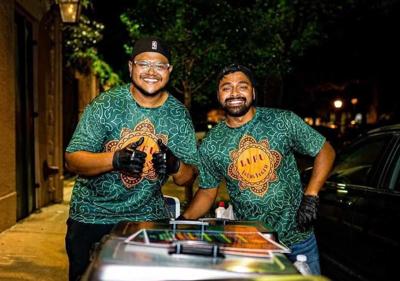Sarthak Samantray and Aman Kota went to culinary schools in their native India, but they met in New Orleans while working in the French Quarter. Samantray grew up in Odisha in eastern India and attended the culinary program at Manipal University. Kota is from Hyderabad and studied at the Culinary Academy of India. They launched their Indian food pop-up Lufu (which stands for “Let Us Feed U”) in June and most weeks they serve food from Friday through Monday at changing locations, which have included Miel Brewery, Pal’s Lounge, The Drifter Hotel, Parleaux Beer Lab, Coffee Science, Café Negril and elsewhere. Find the pop-up on Instagram at @lufu_nola.
Gambit: How did you wind up cooking in New Orleans?
Aman Kota: I graduated from the Culinary Academy of India. After I finished, I worked on a cruise line for one year. I visited 22 or 23 countries. Then I moved to America for work. I came to Branson, Missouri, to do an internship. My friends told me that if I want to learn more about food, I need to come to New Orleans. So I visited New Orleans and I fell in love. So I moved to New Orleans.
Sarthak Samantray: I was 19 when I came to the U.S. I had already finished culinary school. We came to America and got jobs in different hotels. It was a coincidence that we used to work for the same boss. He owned several restaurants and bars around the city. We liked it, and we were appreciated.
K: We used to talk about food. It’s our passion.
S: He’d cook something and bring it to my house. I’d cook something, and we’d get some beers and talk. That’s where Lufu was founded.
K: We were like, we are graduates from the top culinary schools in India. Let’s show people what they don’t know about Indian cuisine.
Gambit: What do you think people should know about Indian food?
S: We learned French techniques in India, because we have a heavy British influence in our food. In certain parts of India, British food is celebrated. But we have our own idea of food. We also are heavily influenced by Middle Eastern food and Persian food. India was ruled by the Mughals for 100 years. There is a heavy food impact on Indian cuisine.
K: People think butter chicken is our only dish. There are so many other things. We’re motivated to change the mindsets of people. They always say, “It’s a curry, so you guys use curry powder?” (In India) we never us curry powder. There is nothing called curry powder in India.
S: Curry is an English term for any kind of gravy or liquidy stuff. To the English, everything is curry in India. But everything is so different. Some things are yogurt based. Some things are tomato and onion based. There’s different types of masala — wet masala and dry masala. We have an upcoming eggplant dish with a wet masala in it, and its coconut based with garlic and onions. It’s so beautiful when you put it together.
We have garam masala. It’s a mix of coriander seeds, cumin seeds, clove, cardamom, bay leaf. You can make your own version.
K: All over India, it’s not about (spicy heat). It’s about flavor.
S: Here, we see mango lassi everywhere. That’s not even a thing in India. I mean, they have mango lassi, but it’s not popular like it is here. There are so many varieties. In my part of India, they drink savory lassis. In India, if you go 30 miles, you find different food, languages, people.
Olvie opens at 7 a.m. daily for breakfast and serves a vast, all-day menu throughout the day.
Gambit: What types of dishes do you like to do for Lufu?
K: We decided to do authentic Indian food no matter what. We decided to change the menu so that they can always try something different.
S: The Royal Frenchmen Hotel was the first to accept us. We did tandoori chicken salad, butter chicken, aloo gobi and gajar ka halwa (carrot pudding).
Every week is a different creation based on the produce (that is available). We look at what regions of India we’ve already covered. We mix and match around India.
K: The first classical regional dish was qurbani ka meetha. It’s from Hyderabad. It’s a dessert of stewed apricot with homemade ice cream.
S: We did shahi tukda (bread pudding) from Lucknow, lamb vindaloo from Goa and bhel puri from Maharashtra. It’s a stew.
K: We do baby eggplant curry, which is famous where I am from. It’s a stuffed eggplant. You make a gravy with onions, tomato and marsala and add the stuffed eggplants and finish it with creamy yogurt sauce and serve it with rice.
S: It sounds weird to mix dishes from different regions. But when you work with it, it’s not, because you’ve studied all these dishes. I studied Indian cuisine from every region and worked around the country. Traveling helped me a lot — going into grandmas’ houses and seeing what they do.
Home cooked Indian food is different than restaurant food. It’s healthy and light. There are a lot of basic stews with rice, or soup with rice. Indian restaurants use a lot of masala, oil, ghee (clarified butter).
K: We want to serve everything. India has so many dishes. We’re only doing three a week, so we can do this for the next 20 years.
Check out the digital edition of this week's Gambit.




